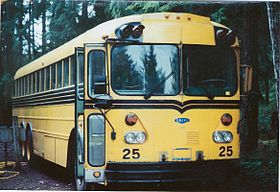Gillig Transit Coach School Bus
| Gillig Transit Coach | |
|---|---|

1977 Gillig 97-passenger Transit Coach Model DT-16, one of the largest school buses ever produced.
|
|
| Overview | |
| Manufacturer | Gillig Brothers (1940–1969) Gillig Corporation (1969–1982) |
| Production | 1940–1982 |
| Assembly | Hayward, California |
| Body and chassis | |
| Class | Type D (transit-style) |
| Body style | School Bus |
| Layout |
Body-on-frame
|
| Platform | Gillig |
| Powertrain | |
| Engine |
Gasoline
Diesel
|
| Capacity | 60-97 passengers |
| Transmission |
|
| Dimensions | |
| Length | 28–40 feet (8.5–12.2 m) |
| Width | 96 inches (2.4 m) |
| Chronology | |
| Successor | Gillig Phantom School Bus |
Body-on-frame
Gasoline
Diesel
The Gillig Transit Coach School Bus is a series of buses that were produced by the American bus manufacturer Gillig. Introduced in 1940, the Transit Coach was produced until 1982. Alongside the similar Crown Supercoach, the Gillig Transit Coach was designed as a transit-style bus (using a rear-engine or mid-engine configuration instead of a cowled chassis); most examples were sold as yellow school buses.
Marketed primarily to operators on or near the West Coast of the United States (California, Washington State, or Oregon), the Gillig Transit Coach was among the largest school buses ever produced. In the late 1950s, the Transit Coach became one of the first school buses powered by a diesel engine.
All examples of the Transit Coach were assembled in Hayward, California, where Gillig currently assembles the Gillig Low Floor/BRT product lines. As school bus production became more competitive in the early 1980s, the Transit Coach was discontinued. In 1986, Gillig re-entered the segment with a variant of the Gillig Phantom adapted for usage as a school bus; the last Gillig school bus was produced in 1993.
In 1937, Gillig Brothers moved from San Francisco to Hayward, California. During this time, transit-style school buses were starting to be developed by a number of manufacturers. As opposed to a conventional-style body mounted on a truck frame, a transit-style bus allowed for greater seating capacity within the same bus length. Additionally, the engine could be mounted in a variety of locations. In 1940, after several years of experimenting, Gillig introduced a production transit-style bus. The bus showcased a design feature unusual for the time: a mid-mounted engine. The Hall-Scott gasoline engine was mounted under the floor on a Fabco chassis bodied by Gillig. During World War II, Gillig bus production was put on hold.
In the post-war years, Gillig resumed production of Transit Coaches alongside conventional-body school buses. A rear-engined version was introduced in 1948, but was not as successful as the mid-engine version. In either configuration, most Gilligs were powered by Hall-Scott engines. Through most of the 1950s, the Transit Coach design had only minor changes.
In 1957, Gillig Brothers purchased the product rights of the Pacific bus product line from Kenworth. The purchase would lead to major design changes for the Transit Coach that would be retained for many years. Alongside Gillig adapting some of Kenworth's body designs, the following changes were made in 1958–1959:
...
Wikipedia
